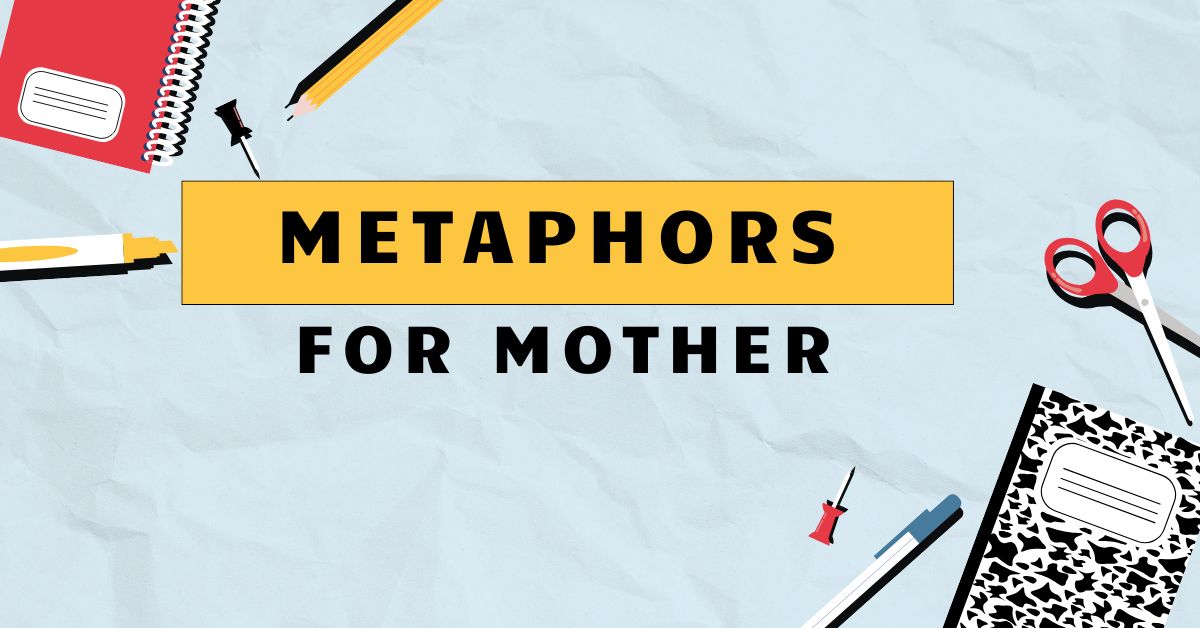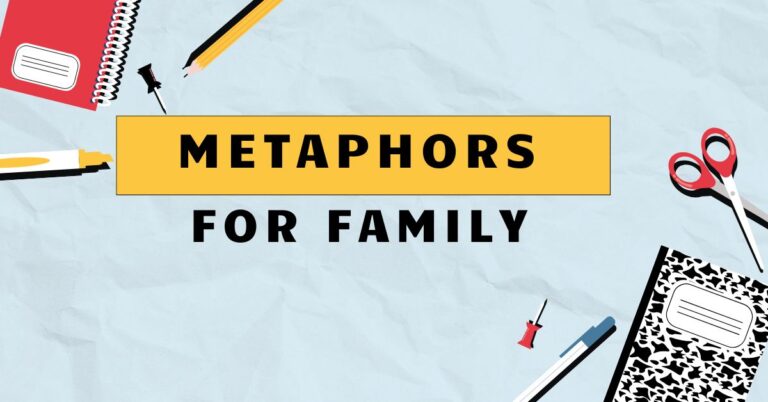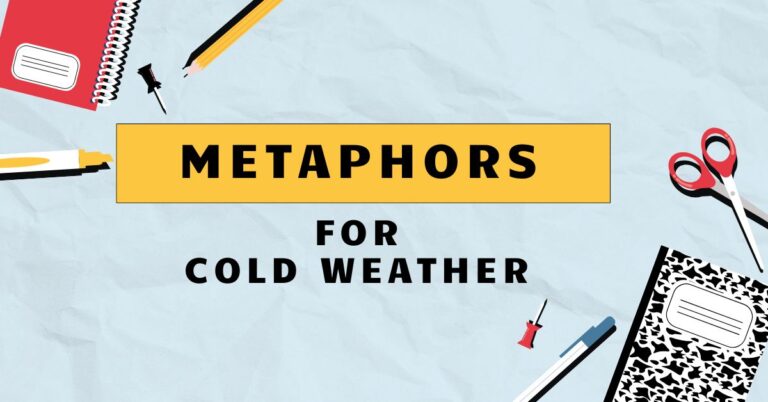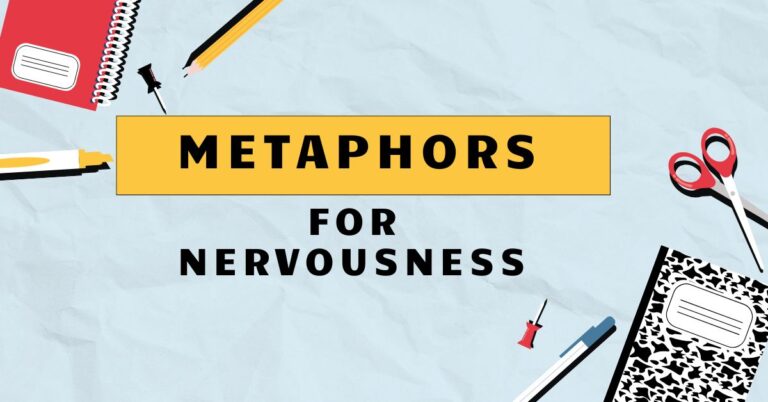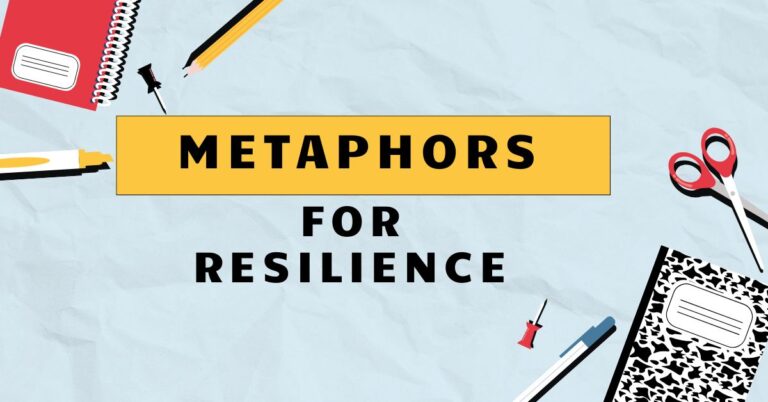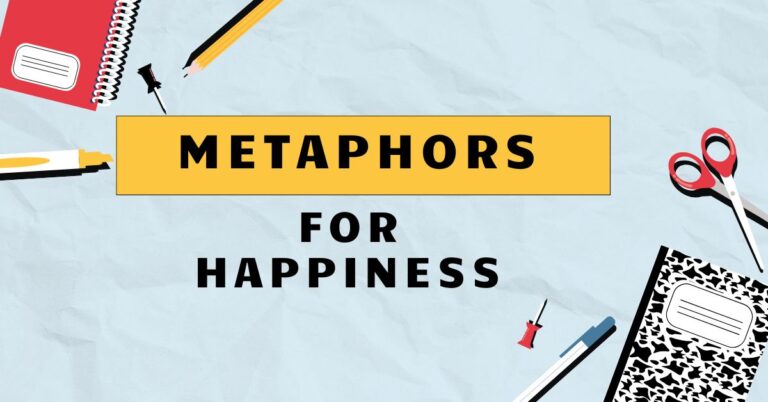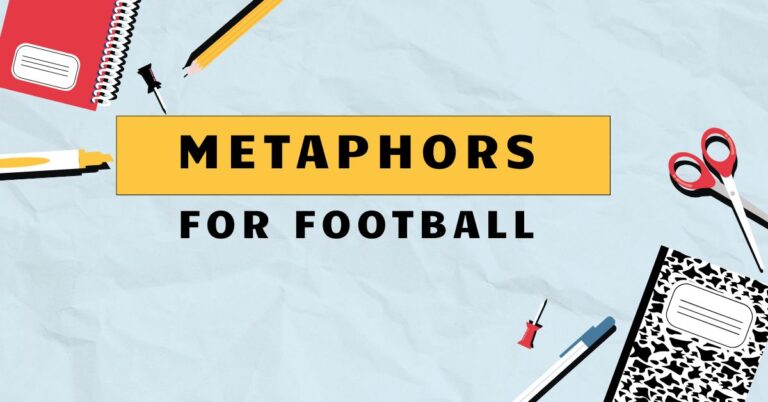31 Metaphors for Mother: Understanding Figurative Language
Understanding metaphors for ‘mother’ deepens our appreciation of figurative language and its impact on communication. This exploration enhances our comprehension of literature, poetry, and everyday speech.
It highlights how abstract qualities of motherhood are conveyed through vivid imagery. This article benefits English language learners, literature students, and anyone seeking to enrich their linguistic skills by recognizing and using metaphors effectively.
It provides a structured approach to identifying, analyzing, and appreciating the art of metaphorical expression related to motherhood.
Table of Contents
- Introduction
- Definition of Metaphor
- Structural Breakdown of Metaphors
- Types of Metaphors
- Examples of Metaphors for Mother
- Usage Rules for Metaphors
- Common Mistakes with Metaphors
- Practice Exercises
- Advanced Topics
- FAQ
- Conclusion
Definition of Metaphor
Ametaphoris a figure of speech that directly compares two unrelated things without using “like” or “as.” It asserts that one thing *is* another, implying a similarity or shared characteristic. Metaphors enhance language by creating vivid imagery and conveying complex ideas in a concise manner.
They are fundamental to creative writing, poetry, and even everyday communication.
Classification of Metaphors
Metaphors can be classified based on their explicitness and how they are used within a text:
- Standard Metaphor: A direct comparison where the similarity is relatively clear.
- Implied Metaphor: The comparison is not explicitly stated but suggested through word choice.
- Extended Metaphor: A metaphor that is developed over several lines or throughout an entire work.
- Mixed Metaphor: A combination of two or more incompatible metaphors, often unintentionally humorous.
Function of Metaphors
Metaphors serve several key functions in language:
- Enhance Understanding: They make abstract concepts more concrete and relatable.
- Create Imagery: They paint vivid pictures in the reader’s mind.
- Add Emotional Impact: They evoke feelings and create a stronger connection with the audience.
- Provide Nuance: They convey subtle shades of meaning that literal language might miss.
Contexts for Metaphor Use
Metaphors are used in a wide range of contexts:
- Literature and Poetry: To create depth, symbolism, and emotional resonance.
- Everyday Speech: To simplify complex ideas and make conversations more engaging.
- Business Communication: To motivate, inspire, and explain strategies.
- Political Discourse: To persuade, influence, and shape public opinion.
Structural Breakdown of Metaphors
Understanding the structure of a metaphor involves identifying its key components:
- Tenor: The subject being described. In the context of this article, the tenor is “mother.”
- Vehicle: The object or concept used to describe the tenor. Examples include “anchor,” “sun,” or “garden.”
- Ground: The shared characteristics or similarities between the tenor and the vehicle.
The relationship between these elements is crucial for a metaphor to be effective. The vehicle should illuminate the tenor, highlighting specific qualities or aspects that resonate with the reader.
Patterns in Metaphorical Language
Metaphorical language often follows certain patterns:
- Personification: Attributing human qualities to inanimate objects or abstract concepts (e.g., “Mother Nature”).
- Synecdoche: Using a part to represent the whole (e.g., “The hand that rocks the cradle rules the world”).
- Metonymy: Substituting a related term for the actual thing (e.g., “The crown” representing the monarch).
Rules Governing Metaphor Formation
While metaphors are inherently creative, there are some implicit rules to consider:
- Relevance: The vehicle should be relevant to the tenor and highlight meaningful similarities.
- Clarity: The metaphor should be understandable and not too obscure.
- Originality: Fresh and original metaphors are more impactful than clichés.
- Consistency: Extended metaphors should maintain a consistent tone and imagery.
Types of Metaphors
Metaphors can be categorized based on their function and complexity.
Standard Metaphors
Standard metaphors are direct comparisons that are relatively easy to understand. They often rely on common associations and shared knowledge.
Implied Metaphors
Implied metaphors do not explicitly state the comparison but suggest it through careful word choice and imagery.
Extended Metaphors
Extended metaphors are developed over several lines or throughout an entire poem or text. They allow for a more in-depth exploration of the similarities between the tenor and the vehicle.
Mixed Metaphors
Mixed metaphors combine two or more incompatible metaphors, often creating a humorous or confusing effect. These should generally be avoided in formal writing.
Examples of Metaphors for Mother
Metaphors for “mother” often focus on nurturing, protection, strength, and guidance. The following examples illustrate the diverse ways in which motherhood can be represented metaphorically.
Mother as a Source of Nurture
These metaphors emphasize the mother’s role in providing care, sustenance, and emotional support.
| Metaphor | Explanation |
|---|---|
| My mother is the wellspring of our family’s love. | Implies that the mother is a continuous and abundant source of love and affection. |
| She is the sun that warms our home. | Compares the mother to the sun, highlighting her warmth, energy, and life-giving presence. |
| My mother is the nourishing soil in which we children grew. | Portrays the mother as providing the essential support and resources for growth and development. |
| Mom is the family’s anchor, steadying us through every storm. | An anchor provides stability; this suggests the mother is a source of unwavering support. |
| She’s the heart of our home, always full of love. | The heart is vital for life, suggesting the mother is essential to the family’s well-being. |
| My mom is the glue that holds our family together. | Glue provides adhesion, implying the mother is what keeps the family connected and strong. |
| She’s the compass guiding us through life’s journey. | A compass provides direction, suggesting the mother offers guidance and helps navigate life. |
| My mother is the garden where we blossomed. | The garden provides life and beauty; this suggests the mother created a nurturing environment for growth. |
| She’s the haven to which we always return. | A haven is a safe place, implying the mother is a source of comfort and security. |
| My mother is the melody that plays in my heart. | Melody is beautiful and soothing, suggesting the mother brings joy and peace. |
| She’s the nurse tending to our every need. | A nurse provides care; this suggests the mother attends to the family’s needs with compassion. |
| My mother is the oxygen we breathe. | Oxygen is vital for life, suggesting the mother is essential to the family’s survival and well-being. |
| She’s the quilt that warms us with love. | A quilt provides warmth and comfort, implying the mother envelops the family in love. |
| My mother is the rose that blooms in our lives. | A rose symbolizes beauty and love, suggesting the mother brings beauty and joy. |
| She’s the shield protecting us from harm. | A shield provides protection, implying the mother safeguards the family from danger. |
| My mother is the teacher who guides us through life’s lessons. | A teacher imparts knowledge, suggesting the mother provides wisdom and guidance. |
| She’s the umbrella sheltering us from life’s storms. | An umbrella provides shelter, implying the mother protects the family from adversity. |
| My mother is the vine that supports our growth. | A vine provides support, suggesting the mother helps the family grow and thrive. |
| She’s the well from which we draw strength. | A well provides water, implying the mother is a source of strength and resilience. |
| My mother is the X factor that makes our family special. | The X factor is a unique quality, suggesting the mother is what makes the family extraordinary. |
| She’s the yarn that weaves our family’s story. | Yarn is used to create fabric, implying the mother connects and weaves the family’s narrative. |
| My mother is the zenith of our family’s happiness. | Zenith is the highest point, suggesting the mother is the source of ultimate joy. |
Mother as a Symbol of Strength
These metaphors highlight the mother’s resilience, courage, and unwavering support.
| Metaphor | Explanation |
|---|---|
| My mother is the rock of our family. | A rock symbolizes stability and strength, suggesting the mother provides unwavering support. |
| She is the lioness protecting her cubs. | Compares the mother to a lioness, emphasizing her fierce protectiveness and courage. |
| My mother is the iron pillar that holds our family together. | Portrays the mother as a strong and unyielding force that provides stability. |
| She is the backbone of our family. | The backbone provides support, suggesting the mother is essential for the family’s strength. |
| My mom is the fortress that protects us from the world. | A fortress provides defense, implying the mother safeguards the family from external threats. |
| She’s the mountain we can always count on. | A mountain is enduring and stable, suggesting the mother is a constant source of support. |
| My mother is the lighthouse guiding us through dark times. | A lighthouse provides guidance, implying the mother helps the family navigate challenges. |
| She’s the oak tree standing tall through every storm. | An oak tree is strong and resilient, suggesting the mother withstands difficulties with grace. |
| My mother is the armor that protects us from harm. | Armor provides protection, implying the mother shields the family from physical and emotional harm. |
| She’s the bridge that connects us to each other. | A bridge links different places, suggesting the mother fosters connection and understanding. |
| My mother is the commander leading us through life’s battles. | A commander leads and directs, suggesting the mother guides the family through challenges. |
| She’s the dynamo powering our family’s engine. | A dynamo generates power, implying the mother is the source of energy and motivation. |
| My mother is the eagle watching over her young. | An eagle is vigilant, suggesting the mother is watchful and protective of her children. |
| She’s the fire that warms us on cold nights. | Fire provides warmth and comfort, implying the mother offers solace and security. |
| My mother is the guardian watching over our dreams. | A guardian protects, suggesting the mother safeguards the family’s aspirations and hopes. |
| She’s the hammer forging our family’s strength. | A hammer shapes and strengthens, implying the mother helps the family develop resilience. |
| My mother is the icebreaker clearing the path for us. | An icebreaker clears obstacles, suggesting the mother removes barriers for the family’s success. |
| She’s the jewel that shines brightly in our lives. | A jewel is precious and valuable, implying the mother is a cherished and important figure. |
| My mother is the knight defending our honor. | A knight defends, suggesting the mother protects the family’s reputation and integrity. |
| She’s the leader guiding us to success. | A leader directs and inspires, suggesting the mother helps the family achieve their goals. |
| My mother is the magnet drawing us together. | A magnet attracts, implying the mother fosters unity and connection within the family. |
| She’s the navigator charting our family’s course. | A navigator guides, suggesting the mother helps the family make informed decisions. |
| My mother is the oracle offering wise counsel. | An oracle provides wisdom, suggesting the mother offers valuable advice and guidance. |
Mother as a Guide
These metaphors reflect the mother’s role in providing direction, wisdom, and moral compass.
| Metaphor | Explanation |
|---|---|
| My mother is the North Star guiding me through life. | The North Star is a constant guide, suggesting the mother provides unwavering direction. |
| She is the map that helps me navigate difficult situations. | A map provides guidance, implying the mother helps navigate life’s challenges. |
| My mother is the wise owl of our family. | An owl is known for wisdom, suggesting the mother offers valuable insights. |
| She’s the beacon illuminating our path. | A beacon provides light, implying the mother guides the family through darkness. |
| My mother is the coach pushing us to achieve our dreams. | A coach provides support and motivation, implying the mother helps the family reach their goals. |
| She’s the doctor healing our wounds. | A doctor provides healing, suggesting the mother mends emotional and physical hurts. |
| My mother is the explorer showing us the world. | An explorer discovers new things, implying the mother broadens the family’s horizons. |
| She’s the fairy granting our wishes. | A fairy grants wishes, suggesting the mother makes the family’s dreams come true. |
| My mother is the governor maintaining order in our lives. | A governor maintains order, implying the mother brings structure and stability. |
| She’s the historian preserving our family’s stories. | A historian preserves the past, suggesting the mother keeps the family’s history alive. |
| My mother is the innovator finding new ways to improve our lives. | An innovator creates new solutions, implying the mother enhances the family’s well-being. |
| She’s the jester bringing laughter to our home. | A jester brings joy, suggesting the mother lightens the mood with humor. |
| My mother is the keeper of our family’s secrets. | A keeper safeguards, suggesting the mother protects the family’s privacy and confidences. |
| She’s the librarian sharing her knowledge with us. | A librarian shares knowledge, implying the mother educates and informs the family. |
| My mother is the magician making our lives extraordinary. | A magician creates wonder, suggesting the mother adds magic to the family’s experiences. |
| She’s the negotiator resolving our conflicts. | A negotiator resolves disputes, implying the mother fosters harmony within the family. |
| My mother is the organizer keeping our family on track. | An organizer maintains order, suggesting the mother keeps the family efficient and structured. |
| She’s the peacemaker settling our arguments. | A peacemaker resolves conflicts, implying the mother fosters peace and understanding. |
| My mother is the questioner challenging us to think critically. | A questioner encourages thought, suggesting the mother promotes intellectual growth. |
| She’s the rebel inspiring us to stand up for what’s right. | A rebel challenges norms, implying the mother encourages the family to fight for justice. |
| My mother is the sage offering timeless wisdom. | A sage provides wisdom, suggesting the mother shares valuable life lessons. |
| She’s the translator helping us understand each other. | A translator bridges communication, implying the mother fosters understanding within the family. |
| My mother is the unifier bringing our family together. | A unifier connects, suggesting the mother fosters unity and harmony. |
Usage Rules for Metaphors
Using metaphors effectively requires careful consideration of context, audience, and purpose. Here are some key rules to keep in mind:
- Choose Appropriate Vehicles: The vehicle should be relevant to the tenor and resonate with the audience.
- Avoid Clichés: Overused metaphors lose their impact and can make your writing sound unoriginal.
- Maintain Consistency: If using an extended metaphor, ensure that the imagery remains consistent throughout.
- Consider Your Audience: Tailor your metaphors to the knowledge and understanding of your audience.
- Use Sparingly: Too many metaphors can overwhelm the reader and detract from your message.
Common Mistakes with Metaphors
Several common mistakes can undermine the effectiveness of metaphors:
- Mixed Metaphors: Combining incompatible metaphors creates confusion.
- Strained Metaphors: Forcing a comparison that doesn’t quite fit.
- Overuse: Using too many metaphors in a short space.
- Misunderstanding the Vehicle: Using a vehicle that the audience may not understand.
Correct vs. Incorrect Examples:
| Incorrect | Correct | Explanation |
|---|---|---|
| My mother is the rock of our family, but she also flies like an eagle. | My mother is the rock of our family. | Mixing “rock” (stability) with “eagle” (freedom) creates a mixed metaphor. |
| She is a volcano of tranquility. | She is a wellspring of tranquility. | Volcanoes are associated with eruptions, not tranquility. |
| My mother is like a beautiful sunset. | My mother is a beautiful sunset. | Using “like” turns it into a simile, not a metaphor. |
Practice Exercises
Test your understanding of metaphors with these exercises.
Exercise 1: Identifying Metaphors
Identify the metaphors in the following sentences:
| Question | Answer |
|---|---|
| 1. My mother’s love is a warm blanket on a cold day. | Love is a warm blanket. |
| 2. She is the glue that holds our family together. | She is the glue. |
| 3. My mother is as sweet as honey. | This is a simile, not a metaphor. |
| 4. She is the light of my life. | She is the light. |
| 5. My mother is a beacon of hope. | Mother is a beacon. |
| 6. Her words are a soothing balm to my soul. | Words are a soothing balm. |
| 7. She faced the challenge like a lioness. | This is a simile, not a metaphor. |
| 8. My mother is the heart of our home. | Mother is the heart. |
| 9. She is the anchor during the storm. | She is the anchor. |
| 10. My mother is a shield protecting us from harm. | Mother is a shield. |
Exercise 2: Completing Metaphors
Complete the following metaphors:
| Question | Answer |
|---|---|
| 1. My mother is a ____ of strength. | pillar |
| 2. She is the ____ in our family’s garden. | sun |
| 3. My mother is a ____ guiding us through life. | compass |
| 4. She is the ____ that warms our souls. | fire |
| 5. My mother is the ____ of our family’s love. | wellspring |
| 6. She is a ____ protecting us from harm. | fortress |
| 7. My mother is the ____ that holds us together. | glue |
| 8. She is a ____ offering wise counsel. | sage |
| 9. My mother is the ____ that charts our course. | navigator |
| 10. She is a ____ watching over her young. | eagle |
Exercise 3: Creating Your Own Metaphors
Create your own metaphors for “mother” using the following prompts:
| Prompt | Example Answer |
|---|---|
| 1. My mother is like a… | My mother is like a comforting melody that soothes my worries. |
| 2. She is the… | She is the steady hand that guides me through uncertainty. |
| 3. My mother’s love is… | My mother’s love is an unyielding flame that warms my heart. |
| 4. She is a… | She is a resilient tree that weathers every storm with grace. |
| 5. My mother is the… | My mother is the quiet strength that empowers me to face any challenge. |
| 6. She’s like a… | She’s like a brilliant star, always shining, even in the darkest night. |
| 7. My mother’s wisdom is… | My mother’s wisdom is a deep well, offering endless insights and clarity. |
| 8. She is a… | She is a skilled weaver, crafting a tapestry of love and memories. |
| 9. My mother is the… | My mother is the gentle breeze that carries my dreams to new heights. |
| 10. She’s like a… | She’s like a protective guardian, always watching over me with love and care. |
Advanced Topics
For advanced learners, exploring the cultural and historical contexts of metaphors can provide deeper insights.
Cultural Significance of Metaphors
Metaphors are often deeply rooted in cultural values and beliefs. Understanding these cultural nuances can enhance your appreciation of literature and communication.
Historical Evolution of Metaphors
The meaning and usage of metaphors can change over time. Studying the historical evolution of metaphors provides a fascinating glimpse into the evolution of language and culture.
Metaphor and Cognition
Cognitive linguistics explores the role of metaphors in shaping our understanding of the world. Metaphors are not just linguistic devices but also fundamental tools for thought and reasoning.
FAQ
Here are some frequently asked questions about metaphors:
- What is the difference between a metaphor and a simile?
A metaphor directly equates two things without using “like” or “as,” while a simile uses “like” or “as” to make a comparison. For example, “She is a lioness” is a metaphor, while “She is *like* a lioness” is a simile. The metaphor asserts that she *is* a lioness, implying strength and protectiveness, whereas the simile suggests a similarity in behavior or characteristics.
- How can I identify a metaphor in a sentence?
Look for statements that equate two seemingly unrelated things. If the statement is literally true, it’s not a metaphor. If it’s a figurative comparison, it’s likely a metaphor. Pay attention to the context and the intended meaning. A metaphor is used to convey a deeper understanding or create a more vivid image.
- What is a mixed metaphor, and why should I avoid it?
A mixed metaphor combines two or more incompatible metaphors, creating a confusing or humorous effect. It should be avoided because it undermines clarity and weakens the impact of your writing. For example, “We must iron out the roadblocks to success” mixes ironing (smoothing) with roadblocks (obstacles), creating an illogical image.
- How can I improve my use of metaphors?
Read widely to expose yourself to different types of metaphors. Practice creating your own metaphors by brainstorming similarities between unrelated things. Pay attention to the context and audience, and choose vehicles that are relevant and understandable. Seek feedback on your metaphors to ensure they are clear and effective.
- Can a metaphor be too subtle?
Yes, a metaphor can be too subtle if the comparison is too obscure or difficult for the audience to understand. An effective metaphor should be clear enough to convey the intended meaning without being overly obvious. Consider your audience’s knowledge and understanding when crafting metaphors.
- Are metaphors only used in literature?
No, metaphors are used in a wide range of contexts, including everyday speech, business communication, and political discourse. They are valuable tools for simplifying complex ideas, creating vivid imagery, and adding emotional impact to your communication.
- How do I avoid using clichés when creating metaphors?
Brainstorm fresh and original comparisons instead of relying on overused phrases. Think about the specific qualities you want to highlight and look for unique vehicles that convey those qualities in a new way. The more original your metaphor, the more impactful it will be.
- What is the role of context in understanding metaphors?
Context is crucial for understanding metaphors because it provides the necessary background information to interpret the intended meaning. The surrounding sentences, the overall tone, and the audience’s knowledge all contribute to how a metaphor is understood. Without context, a metaphor can be misinterpreted or missed altogether.
- How can metaphors enhance communication?
Metaphors enhance communication by making abstract concepts more concrete, creating vivid imagery, adding emotional impact, and providing nuance. They help the audience connect with the message on a deeper level and remember it more easily. Effective use of metaphors can make your writing or speaking more engaging and persuasive.
- What are some examples of metaphors used in everyday language?
Some common examples include: “Time is money,” “Life is a journey,” and “He is a night owl.” These metaphors are so ingrained in our language that we often don’t even realize we’re using them. They help us understand abstract concepts by relating them to more concrete experiences.
- Are some metaphors universally understood?
While some metaphors resonate across cultures due to shared human experiences (e.g., light as knowledge, darkness as ignorance), many metaphors are culturally specific. Understanding the cultural context is essential for accurate interpretation. For example, a metaphor based on a specific animal or plant might not be understood by someone unfamiliar with that species.
Conclusion
Mastering the art of metaphor requires practice and a keen awareness of language. Understanding the structure, types, and usage rules of metaphors allows you to express ideas more creatively and effectively.
By avoiding common mistakes and continually seeking to expand your metaphorical vocabulary, you can elevate your writing and communication skills. As you continue to explore the world of figurative language, remember that metaphors are powerful tools for shaping thought and connecting with others on a deeper level.
Keep practicing and experimenting to unlock the full potential of this essential linguistic device.

